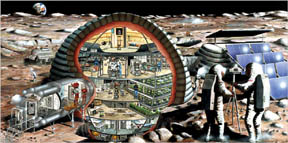|
observer |
|
|
|
|
|
OTHER LINKS |

|

|

|
Life After Earth:Imagining survival beyond this terra firmaWhen the dust settles after World War III, or World War IX, humanity will still want to grow pineapples, rice, coffee and other crops. That is why in June on the island of Svalbard in the Norwegian Arctic, all five Scandinavian prime ministers met to break ground on a $4.8-million "doomsday vault" that will stockpile crop seeds in case of global catastrophe.
While it boasts the extra safety of Arctic temperatures, the seed bank is just the latest life-preservation plan to reach reality, joining genetic banks like the Frozen Ark, a British program that is storing DNA samples from endangered species like the scimitar-horned oryx, the Seychelles Fregate beetle and the British field cricket. To a certain group preoccupied with doomsday, these projects are laudable but share a deep flaw: they are Earth-bound. A global catastrophe - like a collision with an asteroid or a nuclear winter - would have to be rather tame in order not to rattle the test tubes in the various ark-style labs around the world. What kind of feeble doomsday would leave London safe and sound? Cue the Alliance to Rescue Civilization, a group that advocates a backup for humanity by way of a station on the Moon replete with DNA samples of all life on Earth, as well as a compendium of all human knowledge - the ultimate detached garage for a race of packrats. It would be run by people who, through fertility treatments and frozen human eggs and sperm, could serve as a new Adam and Eve in addition to their role as a new Noah. Far from the lunatic fringe, the leaders of the alliance have serious careers: Robert Shapiro, the group's founder, is a professor emeritus and senior research scientist in biochemistry at New York University; Ray Erikson runs an aerospace development firm in Boston and has been a NASA committee chair; Steven M. Wolfe, as a Congressional aide, drafted and helped pass the Space Settlement Act of 1988, which mandated that NASA plan a shift from space exploration to space colonization, and was executive director of the Congressional Space Caucus; William E. Burrows, an author of several books on space, is the director of the Science, Health and Environmental Reporting Program at N.Y.U. President Bush has already proposed a Moon base. "He just needs to be told what it's good for," Dr. Shapiro said. Dr. Shapiro has written a number of books on the origins of life on Earth, as well as "Planetary Dreams: The Quest to Discover Life Beyond Earth," where he unveiled the civilization rescue project. In 1999, the same year the book came out, Dr. Shapiro wrote an essay with Mr. Burrows for Ad Astra, an astronomy journal. There, they formally laid out their plan for the rescue alliance, beginning by warning that "the most enduring pictures to come back from the Apollo missions were not of astronauts cavorting on the Sea of Tranquillity, nor even of the lunar landscape itself." "They were the haunting views of Earth, seen for the first time not as a boundless and resilient colossus of land and water," they continued, "but as a startlingly vulnerable lifeboat precariously plying a vast and dangerous sea: a 'blue marble' in a black void." A conversation shortly after the essay was published, Dr. Shapiro recalled, resounded with the earnest imagination of science fiction drama: Dr. Shapiro: "We've got to use space to protect humanity!" Mr. Burrows: "By God! Yes!" The concept is not new, but there is some fresh momentum. Mr. Burrows's new book, "The Survival Imperative: Using Space to Protect Earth," is due out this month. And the physicist Stephen W. Hawking, who is not part of the group, began arguing this summer that human survival depends on leaving Earth. The mission of the Alliance to Rescue Civilization has also attracted the support of Col. Buzz Aldrin, the second man to walk on the Moon, who now devotes much of his time to the idea of Martian colonization. "It takes a big reason to go to the Moon, because, frankly, it's a lousy place to be," Colonel Aldrin said in a telephone interview. "But this is exactly the kind of planning as a human race we need to secure our future. "But the A.R.C. idea isn't ahead of its time because it's needed right now. It's a reasonable thing to do with our space technology, sending valuable stuff to a reliable off-site location. NASA is certainly not bending backwards to do it. It's the private people like A.R.C." Born and raised within walking distance of the Bronx Zoo - and he walked that distance often - Dr. Shapiro developed an early interest in biodiversity. He frets over the frailty of civilization and the planet, but he is not a pessimist. He compares the Moon-base idea to a safe-deposit box. "It makes sense to protect the things you value," he said. "But we, as a civilization, we don't have anything like that." The trouble with doomsday, Dr. Shapiro argues, is that it is almost always rendered in popular culture as grandiose, though in reality, many minor incidents present substantial everyday threats. In 1918, an influenza strain killed some 30 million people; a possible new bird flu strain spurs contemporary panic. In January 2003, a computer virus shut down airlines, banks and governments. That same year, a tree fell on power lines outside Cleveland, resulting in a blackout for much of the Northeast. Doomsday can be understated. "But I'm not here to predict doomsday; I'm here for sanity," Dr. Shapiro said. "When we've gained what we've gained, we should fight to keep it. "And, worst-case scenario, if it's all for nothing, we'll have a nice museum." |









